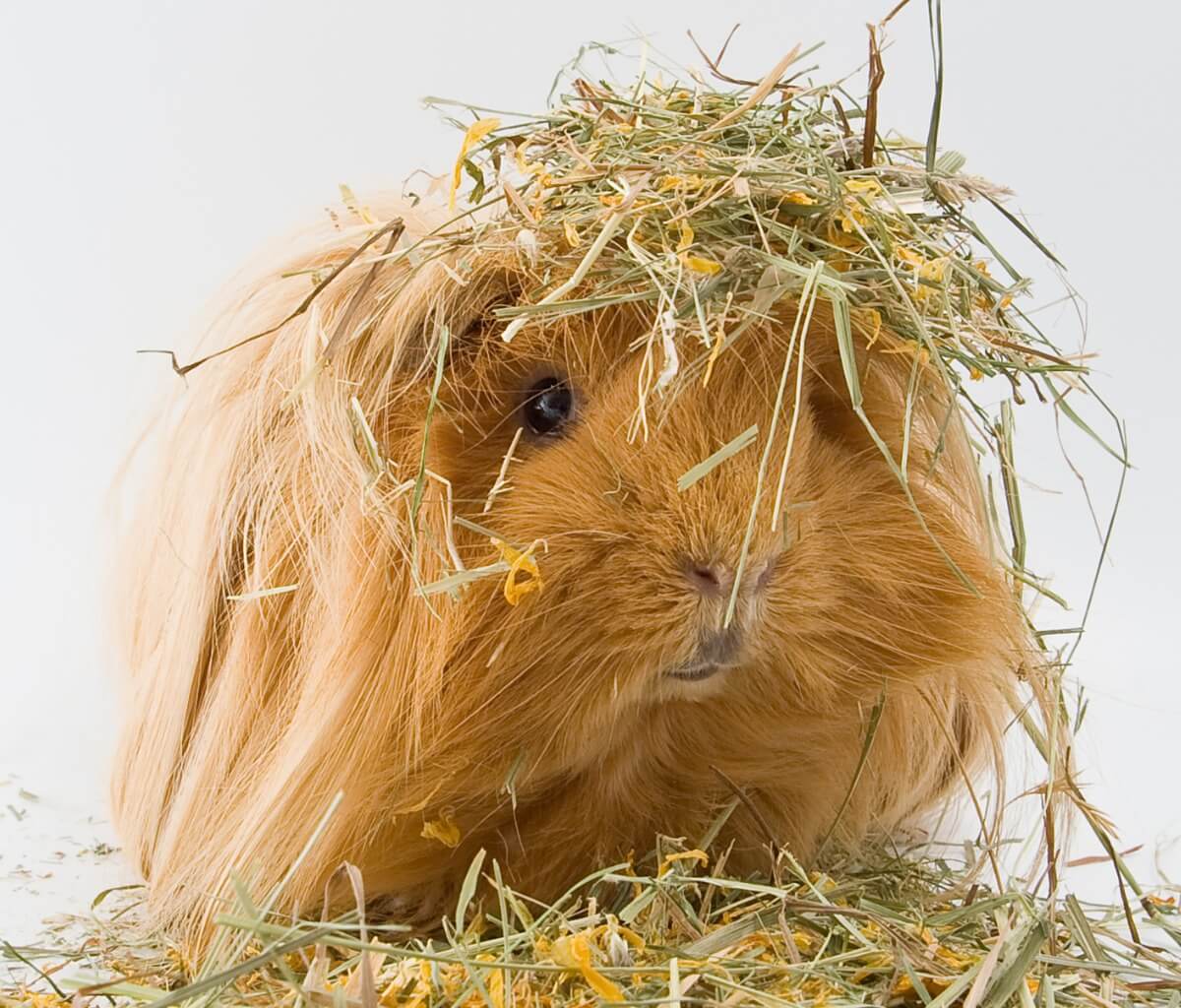Sheltie Guinea Pig: Characteristics, Feeding and Care


Written and verified by the biologist Francisco Morata Carramolino
Guinea pigs are one of the most popular rodents that can be adopted as companion animals. They’re larger, more communicative and allow a higher level of interaction than other similar pets, so they attract a lot of attention. There are many different breeds of guinea pigs: among them, the Sheltie or Silkie guinea pig can be an excellent choice.
This breed comes from the Scottish Shetland Islands and descends from the cross between Peruvian guinea pigs and self black guinea pigs. This is reflected in their physical appearance and long, silky coat, which doesn’t cover their face.
Coupled with their personality, this adorable appearance has made Sheltie guinea pigs one of the most sought after in the world. If you want to know more about them, keep reading.
Characteristics of the Sheltie guinea pig
These guinea pigs usually live between 5 and 8 years, although in exceptional cases they have lived to 14 years. Like other guinea pigs, they are relatively large and plump rodents. Specifically, this breed usually reaches between 20 and 26 centimeters in size.
These animals don’t have a tail and have 4 short legs, of approximately the same size. The head is quite large, with small, rounded ears. The eyes are large, round, black, and shiny. The muzzle is short and finishes in a small pink nose. The mouth is situated in a fairly ventral position.
Its most striking aspect is the long, smooth and soft coat, which can reach up to 60 centimeters in length. The coat can be of various colors, which depend on the individual in particular. Some of the most common shades are black, white, cream or orange.
This long hair can make this breed difficult to distinguish from Peruvian guinea pigs at first glance. Although Peruvian guinea pigs are one of the predecessors of the Sheltie, there’s a clear difference between the two.
The fur of Peruvian guinea pigs grows forward and can cover the animal’s face and eyes. On the other hand, the hair of the Sheltie grows back and becomes shorter on the head. This gives them an adorable and very recognizable appearance, since their head is very rounded and it seems that they have combed their hair back.

The personality of this guinea pig
The Sheltie guinea pig has one of the calmest and most gentle temperaments in their species. It should be noted that, at first, they can be more shy than guinea pigs of other breeds, and gaining their trust can take a little more work than with the rest. However, after this initial period, it’s possible to form a lasting bond with these animals.
Once comfortable in their new home, these guinea pigs are docile, active, playful, and cuddly. They need attention and, like other guinea pigs, they are very communicative. On the other hand, they also require their own space and periods of rest.
Sheltie guinea pig care
As a result of their abundant fur, these rodents require a lot of work. Much of this involves keeping the hair healthy and in good shape.
The hair of these animals becomes tangled and accumulates urine, feces, substrate and other debris or waste. This is annoying for them and can lead to health problems. Therefore, it’s necessary to brush them frequently with a stainless steel comb.
These guinea pigs may also need a bath occasionally. If you’re going to bathe your pet, use very shallow water to avoid stressing the animal. You should also use a special guinea pig shampoo and the water should be lukewarm. When finished, it’s necessary to dry the rodent very carefully, especially on the ears.
Ensuring that the guinea pigs are dry after bathing is very important. As the small rodents that they are, they lose heat very easily, which is harmful. They can be left in a warm and quiet place to finish drying. If you use a dryer, it’s very important to avoid burning them.
Diet and feeding
Like the rest of guinea pigs, the Sheltie is exclusively herbivorous. The main source of food can be hay, which must be provided in almost unlimited quantities and must constitute around 80% of the diet.
Fresh vegetables and feed for guinea pigs can also be provided daily. The feed must be of high quality and without nuts or other fatty foods, which can cause obesity.
Guinea pigs are not capable of synthesizing vitamin C, so it’s a good idea to provide food supplements that contain it. This is especially important for guinea pigs that are older — or weakened by disease.
Guinea pig babies, as well as pregnant mothers, must have a specific diet that’s adequate for their needs. In turn, the cage must always have a source of clean and fresh water, which can be provided in the form of the typical rodent bottle – and must be changed often.
A cage 70 centimeters long and 40 centimeters wide is sufficient for one specimen. In any case, these animals must leave their habitat often.

Sheltie guinea pigs are very friendly and calm animals that can meet the needs of responsible owners. They’re very social rodents, so it’s essential to provide them with the necessary interaction and stimuli.
Guinea pigs are one of the most popular rodents that can be adopted as companion animals. They’re larger, more communicative and allow a higher level of interaction than other similar pets, so they attract a lot of attention. There are many different breeds of guinea pigs: among them, the Sheltie or Silkie guinea pig can be an excellent choice.
This breed comes from the Scottish Shetland Islands and descends from the cross between Peruvian guinea pigs and self black guinea pigs. This is reflected in their physical appearance and long, silky coat, which doesn’t cover their face.
Coupled with their personality, this adorable appearance has made Sheltie guinea pigs one of the most sought after in the world. If you want to know more about them, keep reading.
Characteristics of the Sheltie guinea pig
These guinea pigs usually live between 5 and 8 years, although in exceptional cases they have lived to 14 years. Like other guinea pigs, they are relatively large and plump rodents. Specifically, this breed usually reaches between 20 and 26 centimeters in size.
These animals don’t have a tail and have 4 short legs, of approximately the same size. The head is quite large, with small, rounded ears. The eyes are large, round, black, and shiny. The muzzle is short and finishes in a small pink nose. The mouth is situated in a fairly ventral position.
Its most striking aspect is the long, smooth and soft coat, which can reach up to 60 centimeters in length. The coat can be of various colors, which depend on the individual in particular. Some of the most common shades are black, white, cream or orange.
This long hair can make this breed difficult to distinguish from Peruvian guinea pigs at first glance. Although Peruvian guinea pigs are one of the predecessors of the Sheltie, there’s a clear difference between the two.
The fur of Peruvian guinea pigs grows forward and can cover the animal’s face and eyes. On the other hand, the hair of the Sheltie grows back and becomes shorter on the head. This gives them an adorable and very recognizable appearance, since their head is very rounded and it seems that they have combed their hair back.

The personality of this guinea pig
The Sheltie guinea pig has one of the calmest and most gentle temperaments in their species. It should be noted that, at first, they can be more shy than guinea pigs of other breeds, and gaining their trust can take a little more work than with the rest. However, after this initial period, it’s possible to form a lasting bond with these animals.
Once comfortable in their new home, these guinea pigs are docile, active, playful, and cuddly. They need attention and, like other guinea pigs, they are very communicative. On the other hand, they also require their own space and periods of rest.
Sheltie guinea pig care
As a result of their abundant fur, these rodents require a lot of work. Much of this involves keeping the hair healthy and in good shape.
The hair of these animals becomes tangled and accumulates urine, feces, substrate and other debris or waste. This is annoying for them and can lead to health problems. Therefore, it’s necessary to brush them frequently with a stainless steel comb.
These guinea pigs may also need a bath occasionally. If you’re going to bathe your pet, use very shallow water to avoid stressing the animal. You should also use a special guinea pig shampoo and the water should be lukewarm. When finished, it’s necessary to dry the rodent very carefully, especially on the ears.
Ensuring that the guinea pigs are dry after bathing is very important. As the small rodents that they are, they lose heat very easily, which is harmful. They can be left in a warm and quiet place to finish drying. If you use a dryer, it’s very important to avoid burning them.
Diet and feeding
Like the rest of guinea pigs, the Sheltie is exclusively herbivorous. The main source of food can be hay, which must be provided in almost unlimited quantities and must constitute around 80% of the diet.
Fresh vegetables and feed for guinea pigs can also be provided daily. The feed must be of high quality and without nuts or other fatty foods, which can cause obesity.
Guinea pigs are not capable of synthesizing vitamin C, so it’s a good idea to provide food supplements that contain it. This is especially important for guinea pigs that are older — or weakened by disease.
Guinea pig babies, as well as pregnant mothers, must have a specific diet that’s adequate for their needs. In turn, the cage must always have a source of clean and fresh water, which can be provided in the form of the typical rodent bottle – and must be changed often.
A cage 70 centimeters long and 40 centimeters wide is sufficient for one specimen. In any case, these animals must leave their habitat often.

Sheltie guinea pigs are very friendly and calm animals that can meet the needs of responsible owners. They’re very social rodents, so it’s essential to provide them with the necessary interaction and stimuli.
All cited sources were thoroughly reviewed by our team to ensure their quality, reliability, currency, and validity. The bibliography of this article was considered reliable and of academic or scientific accuracy.
- https://thepetfaq.com/sheltie-guinea-pig/
- https://www.guineapighub.com/silkie-guinea-pig/
- http://mgpr.org/newsite/GP_Info/Guinea%20Pig%20Diet.htm
This text is provided for informational purposes only and does not replace consultation with a professional. If in doubt, consult your specialist.








